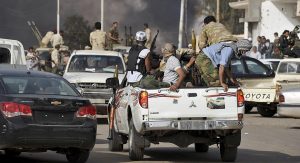
A group of girls were walking home from school in a quiet Libyan town on Nov. 21, when a pet monkey from a shop jumped over one of them and retreated to the shop with her headscarf. It could have been a funny incident — people could have just laughed about it and then forgot the whole thing. But not in Sabha, an oasis city in southern Libya, where tribal tensions have been simmering with occasional violent eruptions since the regime of Moammar Gadhafi was toppled with help from NATO in October 2011.
Right after she got home, the girl, whose name has not been released, told her family what happened. A few minutes later, members of her family shot dead the shopkeeper and his monkey. News of the event quickly spread around the city, and full war erupted between the two main tribes in Sabha — Awlad Suleiman, to which the girl belongs, and the shopkeeper’s Qadhadhfa tribe, the same as that of the late Gadhafi.
It is hard to give a precise figure, but by the time tribal mediators brokered a cease-fire 10 days later, 20 people were killed while 50 others were injured, according to news reports and social media pages. Properties, including private homes and schools, sustained extensive damage.
This was the fiercest fighting seen by Sabha since 2013, when two other tribes, Tibu and Tuareg, fought a bloody battle over control of trafficking routes running from Sabha to sub-Saharan countries, including Chad and Niger.
Was this incident yet another episode of Libya’s never-ending little wars, or does it have to do with something bigger in the troubled country, where tribal relations are strong, poisonous and could easily be stirred up in deadly outbursts?
Although what happened was an act of irresponsible individuals who had no difficulty finding arms in a country with no effective government control or strong policing, this particular incident in Sabha is actually indicative of how intricate and complex tribal relations can be. Both tribes — Awlad Suleiman and Qadhadhfa — have been very strong allies since the early 1920s, when they fought the Italian invasion and subsequent colonization of Libya. They have a long history of aiding one another with another strong tribal ally, the Warfalla in Bani Walid, 180 km (about 112 miles) southwest of Tripoli.
Libya’s recent history is full of stories praising the three tribes’ patriotism and bravery. In April 1929, they led the Battle of Qasr Abu Hadi, one of the most famous liberation battles against Italian invaders near Sirte. During the Gadhafi era, the three tribes took the most risks and made the most important power grabs over 40 years.
All that changed in 2011, after the regime fell at the end of a bloody eight-month civil war. When the so-called the Libyan revolution erupted in February 2011, both tribes kept their old alliance. But as the war prolonged and it became apparent that NATO would destroy the regime, fearing rebel reprisals, some members of Awlad Suleiman in Sabha had a change of heart and joined the opposition. This left Awlad Suleiman’s old allies, Qadhadhfa, fending for themselves, particularly in Sirte, where Gadhafi made his last stand and was later murdered at the hands of the rebels on Oct. 20, 2011.
This shift seemed at the time a small crack in a long history of solidarity between the two tribes that could be healed as time passed, and people reconciled to the new fact that, with the Gadhafi regime gone, Libya had changed. However, deep political polarization during the war in 2011 resulted in a lack of serious reconciliation along tribal lines and alliances in wider Libyan society. Families and tribes were divided into two camps based on political beliefs: those who supported the NATO-backed rebels and those who didn’t.
The majority of Qadhadhfa members supported the regime, while most Awlad Suleiman members supported the revolution, mainly because one of their own was appointed as a high-ranking official in the National Transitional Council, which represented the rebels during the war. Abdul Majid Seif al-Nasr, one of Awlad Suleiman’s most influential leaders, represented his tribe on the council and later served as Libya’s general consul to Morocco. But no one expected such political differences to boil over into war between the two neighbors and longtime allies, particularly in Sabha.
The incident in Sabha is only a glimpse of how deep tribal divisions are and how seriously detrimental they could be to the whole country’s future, because the entire Libyan social fabric is based on tribal loyalty, which precedes loyalty to the state. Tribal loyalty has dominated the country for decades, well before Gadhafi came to power in 1969. This factor weakened any state loyalty during times of war and peace.
In Sabha, reconciliation and mediation efforts succeeded in bringing about a cease-fire and the signing of a tribal agreement between the two warring sides, hoping that wisdom will prevail and both sides will recall their long and shared history of brotherhood and solidarity.
But this is no guarantee for the future unless Libya unifies under a strong central government, which could exercise authority over the whole country, disarm the militias and collect weapons within a national reconciliation program. Otherwise, the recent war in Sabha could and will be repeated in other parts of Libya, where tribal grudges could easily be stirred up by a small event like the pet monkey in Sabha.
